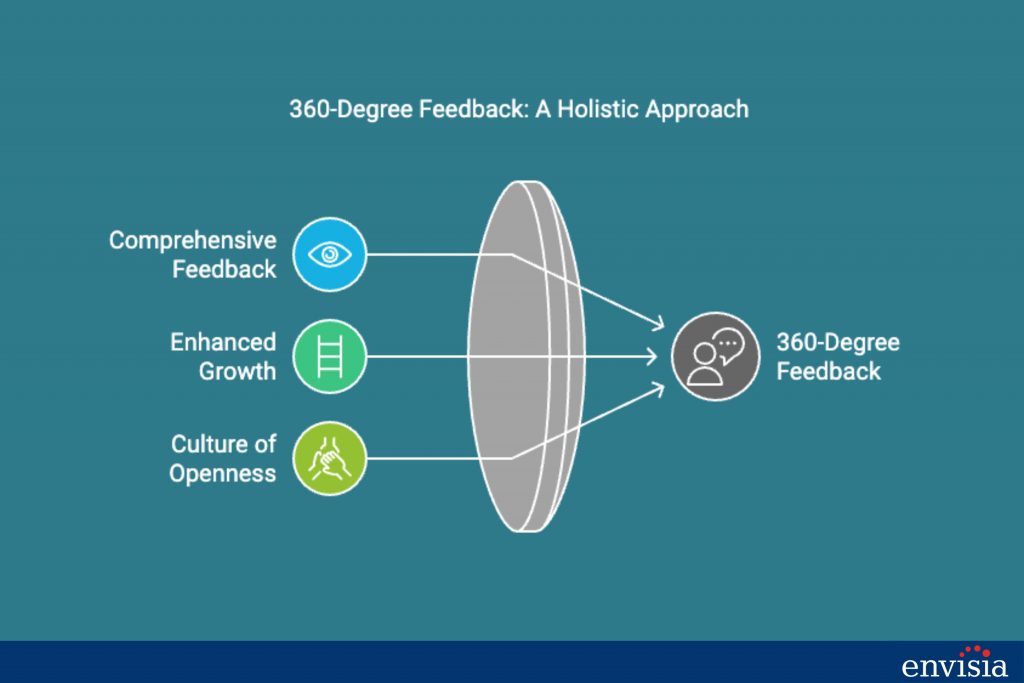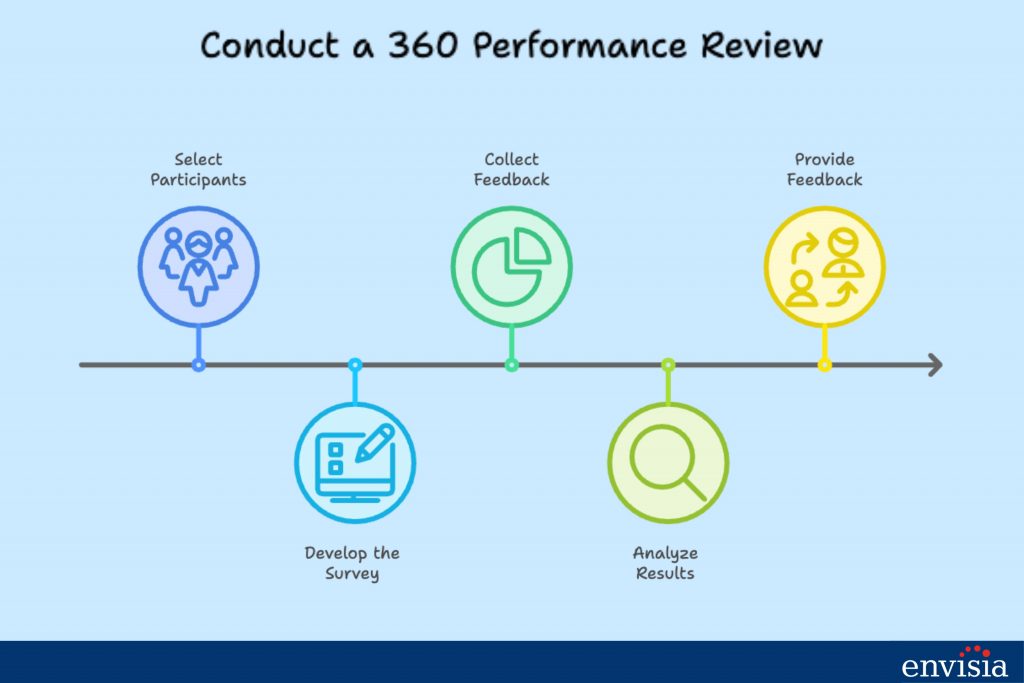Have you ever felt like traditional performance reviews don’t fully capture your contributions or offer meaningful insights for growth? You’re not alone.
If you’ve received feedback that seemed limited or one-sided, it’s possible you were missing the perspectives of those you interact with daily—such as peers, direct reports, or even clients. This narrow view can make it difficult to see the bigger picture and hinder your growth. Fortunately, a solution to gain more well-rounded feedback is the 360-degree review process.
By collecting input from multiple sources, 360 reviews provide a complete perspective on your strengths and areas for improvement. This multi-source evaluation can boost your development, strengthen team dynamics, and contribute to organizational success. Let’s explore how 360 feedback can transform your approach to performance management.
Key Takeaways
- Comprehensive Feedback: Gain insights from managers, peers, and direct reports to form a complete picture of your performance.
- Enhanced Growth: The 360 review process helps you identify areas for improvement and set clear, actionable goals.
- Culture of Openness: Implementing 360-degree feedback encourages open communication and builds trust within teams, creating a more collaborative environment.

What is a 360-degree Review?
360 Review Explained
The 360-degree review is a comprehensive evaluation method that gathers feedback from multiple sources—managers, peers, direct reports, and sometimes even customers. Unlike a typical performance review and 360 degree feedback, that relies solely on a manager’s perspective. This approach provides a more balanced view of an individual’s performance, offering insights from all perspectives. By receiving input from various angles, you gain constructive insights into your strengths and weaknesses, fostering self-awareness and professional growth.
Traditional Review vs. 360 Review
In a traditional performance review, feedback is often limited to the manager’s observations, which can overlook valuable perspectives. The 360 review helps offer a holistic view of your job performance by however, includes input from those who interact with you regularly, offering a holistic view of your job performance. This review gathers feedback that is more representative of your contributions, enhancing the accuracy and fairness of the evaluation.

Benefits of 360-Degree Feedback
Implementing 360-degree feedback provides numerous advantages. It encourages open communication, builds trust among team members, and identifies areas where you can enhance your skills. This approach aligns with best practices in performance management, helping to improve employee’s work performance and drive organizational success. By embracing feedback from multiple sources, you can better understand how your actions impact others and make informed decisions about your professional development.
For more detailed insights on the benefits of 360, visit our in-depth blog on the benefits of 360-degree feedback.

How the 360 Review Process Works
360 Review Process Step-by-Step
Conducting a 360 performance review involves several key steps:
- Select Participants: Choose a diverse group of individuals who can provide feedback, including managers, peers, and direct reports.
- Develop the Survey: Create a 360 survey with great questions that target specific competencies and behaviors relevant to the role.
- Collect Feedback: Distributing the survey using performance management software and tools can streamline the 360 degree review process. to ensure the entire process is efficient and confidential.
- Analyze Results: Review the feedback to identify common themes, strengths and weaknesses, and areas for improvement.
- Provide Feedback: Schedule a meeting to discuss the findings, focusing on constructive feedback and setting actionable goals.
Conducting a 360 Review
To effectively use 360 reviews, it’s essential to communicate the purpose and benefits of the 360 degree process clearly. Training participants on how to give feedback constructively ensures that the insights are valuable and respectful. Utilizing tools like free 360 templates can simplify administration and encourage honest responses.
Who Should Participate in a 360-Degree Review?
Selecting the right participants is crucial for a successful 360-degree evaluation. Include individuals who interact closely with the employee, such as managers, peers, and direct reports. This diversity ensures that the feedback collected is well-rounded and reflects various perspectives on the team members’ performance.
360 Review Example
A 360 review typically includes questions like:
- “How effectively does the employee communicate with team members?”
- “Can you provide specific examples of the employee’s leadership abilities?”
- “What are some areas for improvement for this employee?”
These questions help gather detailed insights that can guide the staff member’s development.
360-Degree Feedback Best Practices
Setting SMART Goals for 360 Performance
After receiving feedback, setting SMART goals is crucial for effective employee performance reviews and achieving positive outcomes. (Specific, Measurable, Achievable, Relevant, Time-bound) is essential for effective employee performance reviews and turning insights into action. This approach helps employees focus on specific areas for improvement and track progress over time, enhancing the effectiveness of the 360-degree review process.
Training Employees for the 360-Degree Review Process
Educating both employees and managers on how to provide feedback and interpret results is vital in the 360 degree review process. Training fosters a supportive environment where everyone understands the value of constructive feedback and feels comfortable participating. This preparation ensures that the feedback process leads to successful 360 results and meaningful growth.
Best Practices for Collecting and Analyzing 360 Feedback
To get the most out of a 360 program:
- Ensure Confidentiality: Protect the privacy of those involved in the 360 evaluation. Protect participants’ anonymity to encourage honesty.
- Use Reliable Tools: Employ performance management software or trusted survey platforms to administer 360 surveys effectively.
- Focus on Actionable Insights: Look for patterns and trends rather than isolated comments.
- Follow-up: Schedule regular check-ins to assess progress on development plans.

Conducting a 360 Performance Review: Best Practices for Success
360 Review Evaluation Methods
Various methods can enhance the evaluation process:
- Digital Surveys: Efficient for data collection and analysis.
- External Consultants: Offer objective perspectives and expertise.
- Peer Review: Adds depth by including insights from colleagues.
By combining these methods, organizations can obtain a comprehensive picture of their performance evaluations.
Ensuring Confidentiality in the 360 Review Process
Maintaining confidentiality is crucial. An anonymous review process gathers feedback responses candidly and builds trust. Ensure that data is securely stored and that participants understand how their feedback will be used.
Debriefing After a 360 Performance Review
After the review, a thoughtful debriefing session between the manager and employee is essential. Discuss the findings openly, focusing on constructive feedback and collaborative goal-setting. This dialogue helps the employee feel supported and motivated to act on the insights.
Turning Feedback into Action
The true value of a 360-degree assessment happens when you convert feedback into tangible steps. Develop a plan that outlines specific actions, timelines, and resources needed. Using this strategy means an employee may take ownership of their development and recognize how their efforts contribute to the organization’s success through 360-degree evaluations.
Common Pitfalls and Challenges in the 360 Review Process
Time-Consuming Nature of 360 Reviews
The 360-degree review can be time-intensive, which may strain resources. To mitigate this, implement 360 reviews efficiently with tools like digital surveys. Make 360 feedback a part of your regular review cycle to integrate it seamlessly into your workflow.
Managing Negative Feedback in 360 Reviews
Receiving negative feedback can be challenging. However, it should be seen as an opportunity to improve their performance, helping both the individual and the team. With the right approach, an employee gets more value from the 360-degree process.
360-Degree Feedback Program Examples
360 Review Success Stories
Companies like Netflix have successfully implemented 360-degree review programs. By fostering a culture of open communication and continuous improvement, they leverage 360 feedback to enhance employee performance and drive innovation. According to the Harvard Business Review, such programs can lead to higher engagement and productivity.
Free 360 Review Tools and Templates
To get started, consider using free 360 templates available online. Tools like TalentTools, SurveyMonkey and Google Forms offer customizable options that make it easy to administer your 360 assessments. These resources simplify the process, allowing you to focus on the insights gained.
Why Your Organization Needs a 360-Degree Review Process
Recap of 360-Degree Feedback Benefits
Adopting a 360-degree review process offers a wealth of benefits:
- Enhanced Employee Performance: By highlighting both strengths and areas for improvementWith 360 degree feedback, employees can focus on targeted growth.
- Stronger Team Dynamics: Open communication fosters trust and collaboration among team members.
- Effective Leadership Development: Identifying potential leaders and providing them with comprehensive feedback accelerates their growth.
Implementing Your Own 360 Review Process
Embracing the 360° review is a powerful step toward a more dynamic and supportive workplace. Start by educating your team about the process and its benefits. Utilize available tools to streamline administration, and commit to an ongoing cycle of feedback and development. By using effective employee reviews, you can help participants reach their full potential and also propel your organization toward greater success.

Conclusion
In embracing the 360-degree feedback process, organizations undertake a procedure or approach that needs thoughtful planning but yields significant rewards. Employees feel more understood when using 360 feedback, as this method offers a comprehensive look at their performance rating beyond what one review can provide. The purpose of a 360 is to foster performance improvement by capturing diverse perspectives through 360 review surveys.
By conducting 360 reviews throughout the review period, rather than just during the annual review, you create continuous growth opportunities. Ultimately, 360 reviews are a powerful tool that both employees need and benefit the employee and the organization, helping individuals perform and thrive.
